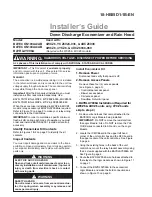
7
4. Power and Communication Wiring for
Systems
CAUTION
This unit must be properly grounded and protected by a
circuit breaker. The ground wire for the unit must not be
connected to a gas or water pipe, a lightning conductor or
a telephone ground wire.
Do not connect power wires to the outdoor unit un-
til all other wiring and piping connections have been
completed.
Install all wiring at least 3 feet (1 m) away from televi-
sions, radios or other electronic devices in order to
avoid the possibility of interference with the unit op-
eration.
Do not install the unit near a lighting appliance that in-
cludes a ballast. The ballast may affect remote control
operation.
WARNING
Isolate the power supply before accessing unit electri-
cal terminals.
Install unit so that unit disconnect is accessible.
Follow all local and national codes, as well as this
installation instruction, during installation. Do NOT
overload electrical circuit, as this may lead to failure
and possible fire.
Use specified wiring and cable to make electrical con
-
nections. Clamp cables securely and make sure that
connections are tight to avoid strain on wiring. Inse-
cure wiring connections may result in equipment fail-
ure and risk of fire. Wiring must be installed so that all
cover plates can be securely closed.
In the U.S.A., wiring must conform with current local codes
and the current National Electric Code (NEC). In Canada,
wiring must conform with current local codes and the current
Canadian Electrical Code (CEC).
4.1. Overview
Refer to unit nameplate for minimum circuit ampacity and
maximum over-current protection size.
•
All indoor units are powered by the outdoor unit.
•
Make all electrical power wiring connections at the
outdoor unit.
•
Size outdoor unit power per local code and power
requirements.
•
Connect wiring between indoor and outdoor terminals.
•
Refer to unit name plate for rated voltage.
•
Be sure to reattach all electrical box covers after
connections are complete.
•
Follow NEC/CEC standards and all local and state
codes during wiring installation.
See “Table 1. Single Zone Installation Wiring Requirements”
and “Table 2. Specifications” on page 10 for wiring
requirements.
4.2. Wire Gauge
Table 1. Single Zone Installation Wiring Requirements
Systems
and T
erminal
Designations
System Capacity
System V
oltage
Number of Conductors
W
ire T
ype
W
ire Gauge / MCA
Indoor to
Outdoor Wiring
(Communication/
Power)
1, 2, 3 and GND
12K
115VAC
4
Stranded
and
shielded
or
unshielded
16AWG
Outdoor to Main
Power
L, N and GND
12K
115VAC
3
14AWG /
15A
Indoor to Outdoor
Wiring
(Communication/
Power)
1, 2, 3 and GND
09K
208/230VAC
4
16AWG /
10A
Indoor to Outdoor
Wiring
(Communication/
Power)
1, 2, 3 and GND
12K
208/230VAC
4
16AWG /
11A
Outdoor to Main
Power
L1, L2 and GND
09K and
12K
208/230VAC
3
16AWG
/ 9A
Indoor to Outdoor
Wiring
(Communication/
Power)
1, 2, 3 and GND
18K and
24K
208/230VAC
4
16AWG
Outdoor to Main
Power
L1, L2 and GND
18K and
24K 208/230VAC
3
14AWG /
18A
MCA = Minimum Circuit Amps








































